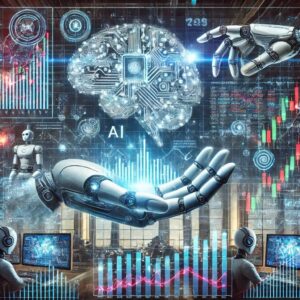AI is “Tearing Apart” Companies, Survey Finds
As artificial intelligence (AI) continues to push the boundaries of innovation and efficiency across various sectors, a new survey has emerged revealing startling insights into its impact on businesses. The findings suggest that while AI presents remarkable opportunities for growth and productivity, it also poses significant challenges that are “tearing apart” companies from the inside out.
The Dual-Edged Sword of AI
Artificial intelligence has quickly become a dual-edged sword for many organizations. On one hand, companies are leveraging AI to streamline processes, enhance customer experiences, and drive data-driven decision-making. On the other hand, the rapid adoption of AI technologies is leading to unprecedented levels of disruption within corporate structures.
The survey conducted by Axios indicates that businesses are grappling with the integration of AI into their workflows. As organizations rush to deploy AI solutions, they are often met with resistance from employees who fear job displacement or feel unprepared to adapt to new technologies. This disconnect can lead to internal strife, decreased morale, and reduced productivity.
Survey Insights: Understanding the Disconnect
The Axios survey highlights several key areas where AI is causing friction within companies:
1. Employee Anxiety and Job Security: A significant portion of the workforce expresses concern that AI will replace their jobs. This fear can create a culture of uncertainty, leading to resistance against adopting AI technologies. Human resources departments are seeing an uptick in inquiries related to job security and potential layoffs linked to automation.
2. Skill Gaps: Many employees lack the necessary skills to work alongside AI tools effectively. This skills gap can hinder the successful implementation of AI solutions, resulting in wasted resources and missed opportunities. Companies must invest in training and development programs to bridge this gap, or risk falling behind.
3. Cultural Resistance: Introducing AI into an organization often requires a cultural shift. Employees accustomed to traditional methods may resist change, leading to a fragmented approach to AI integration. Achieving a cohesive strategy that aligns with the company’s vision is crucial for successful AI adoption.
4. Misalignment of AI Goals: Organizations frequently fail to establish clear objectives for their AI initiatives. Without a well-defined purpose, AI projects can veer off course, wasting time and resources. Companies must ensure that their AI strategies align with overall business goals to maximize the benefits of these technologies.
Strategic Approaches to AI Integration
To mitigate the challenges posed by AI and foster a more harmonious workplace, organizations must implement strategic approaches to integration. Here are some actionable steps companies can take:
1. Foster Open Communication: Transparency is key to alleviating employee concerns about AI. Organizations should openly discuss the role of AI in the workplace, emphasizing how it will enhance rather than replace human capabilities. Regular updates and forums for employee feedback can create a more inclusive culture surrounding AI adoption.
2. Invest in Training Programs: Building an AI-literate workforce is essential for ensuring that employees feel confident in their abilities to work with new technologies. Companies should prioritize training and development initiatives that focus on upskilling employees in AI-related competencies, such as data analysis and machine learning.
3. Cultivate a Culture of Innovation: Encouraging a culture that embraces change and innovation can ease the transition to AI. Organizations should inspire employees to think creatively about how AI can enhance their roles and responsibilities. Celebrating successes and sharing positive outcomes can help foster a more enthusiastic approach to AI integration.
4. Align AI Goals with Business Strategies: To avoid misalignment, organizations must establish clear objectives for their AI initiatives that resonate with their overall business strategies. This alignment ensures that AI projects contribute meaningfully to the company’s success, rather than becoming standalone efforts.
The Future of AI in the Workplace
As AI technology continues to advance, its influence on the workforce will only grow. Companies that proactively address the challenges posed by AI will be better positioned to harness its potential. The key lies in balancing the benefits of AI with the needs and concerns of employees.
The Axios survey illustrates that while AI has the power to transform businesses, it also requires meticulous planning and execution to avoid internal strife. By prioritizing communication, training, and alignment, companies can navigate the complexities of AI integration and emerge stronger in the face of disruption.
Conclusion: Embracing Change for a Competitive Edge
In conclusion, the integration of AI into business operations represents a critical juncture for many companies. The Axios survey underscores the importance of understanding the emotional landscape surrounding AI adoption. While the technology offers a wealth of opportunities, organizations must also acknowledge and address the associated challenges.
By fostering an environment of open communication, investing in employee training, and ensuring alignment with business strategies, companies can transform the AI narrative from one of fear and resistance to one of collaboration and innovation. The future of work is undoubtedly intertwined with AI, and those who embrace this change will find themselves at the forefront of their industries, equipped with a more agile and capable workforce.
As businesses navigate this new landscape, they are reminded that the success of AI implementation hinges not solely on technology, but also on the people who drive its potential. Embracing AI as a partner rather than a threat is the first step toward leveraging its capabilities for sustainable growth and success.



